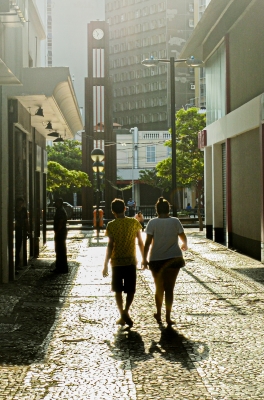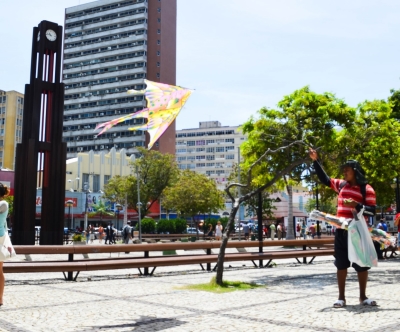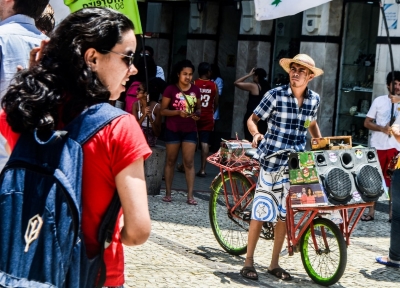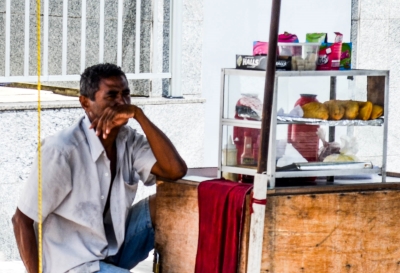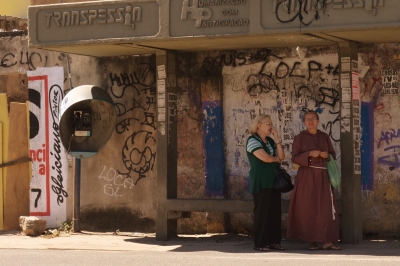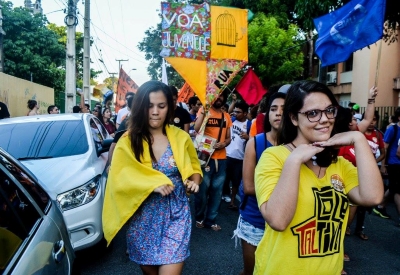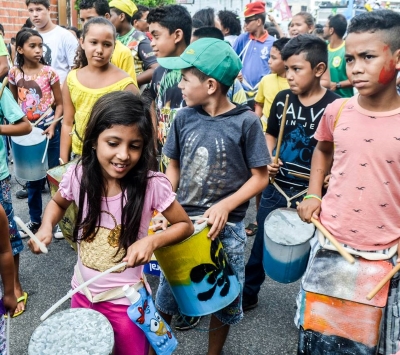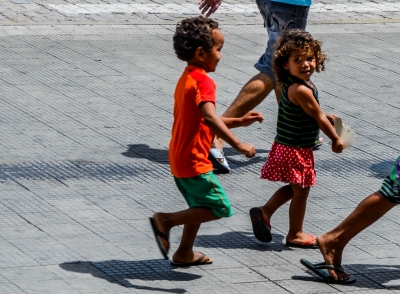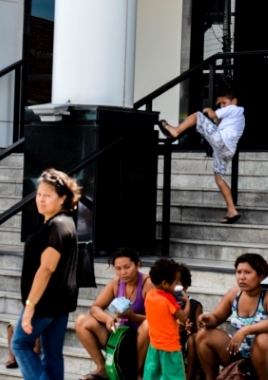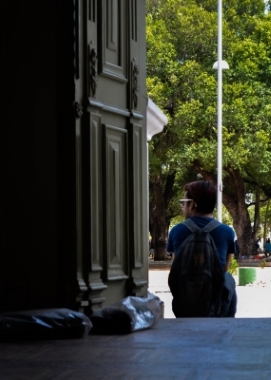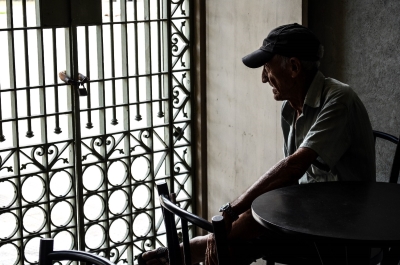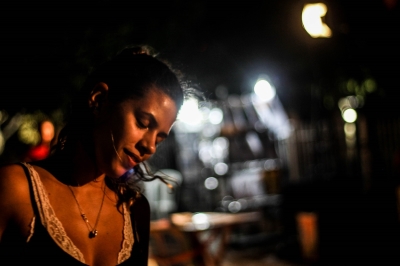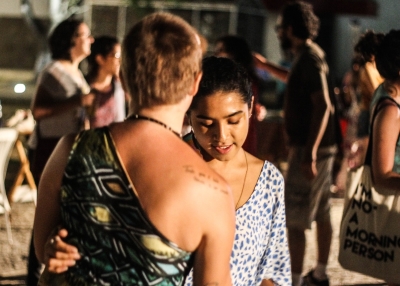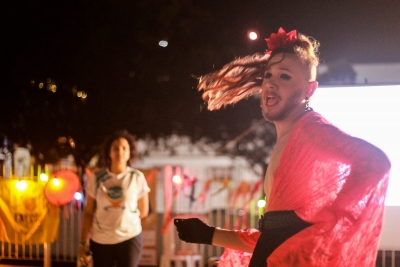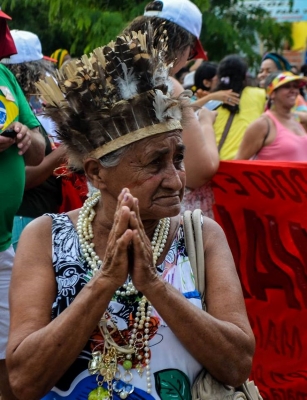Serviços Personalizados
Journal
Artigo
Indicadores
-
 Citado por SciELO
Citado por SciELO -
 Acessos
Acessos
Links relacionados
-
 Similares em
SciELO
Similares em
SciELO
Compartilhar
Vista. Revista de Cultura Visual
versão On-line ISSN 2184-1284
Vista no.8 Braga dez. 2021 Epub 01-Maio-2023
https://doi.org/10.21814/vista.3389
Visual Projects
Photographic Chapters in the Centre of Transient Fortaleza
1 Faculdade de Filosofia e Ciências Humanas, Universidade Federal de Minas Gerais, Belo Horizonte, Brasil
2 Instituto de Cultura e Arte, Universidade Federal do Ceará, Fortaleza, Brasil
Fortaleza is a Brazilian city with more than 2,500,000 inhabitants and a density of 7,786.44 hab/km², the highest demographic density among Brazilian capitals (Brazilian Institute of Geography and Statistics [IBGE], 2010). It also ranks among the top ten urban metropolises in the country (IBGE, 2018). We are a port marked by profound inequality shown in the differences observed in the human development index (HDI; Fundação Demócrito Rocha, 2021), where the Meireles neighbourhood has 0.953 — higher than Norway (0.944), which ranks first in the world — and the Praia do Futuro II neighbourhood hits 0.167 — lower than that of Niger (0.348), ranked last in the world.
The centre is part of Fortaleza and, as an element of a Brazilian metropolis, is permeated by different interests that see it as an invented destination in the composition of the postcard built for the tourism market, to the detriment of the daily dynamics that articulate and animate urban space. This research, facing the friction of imagery on the territory and awareness of the place of imagery produced in the construction of social memory, is developed in field action-oriented in bonds of proximity (Magnani, 2008) to take notes and constitute photographic inscriptions. From these bonds, based on the teachings of Martins (2016), the goal is to compose visual poetics about the space in dispute.
In this dynamic, a city centre is a place of sharing and collective experience in the complex territory that makes up the metropolis. At the threshold of interests and different uses of space, this area is in constant dispute: whether the legal battles to define the legal directions of the place or the symbolic battles for the composition of the imaginary about it. The centre is a collective locus, and so the composition of a panoramic photograph of Fortaleza and its contradictions converges.
The disputes that engender a capital city on the move like Fortaleza take place not in the deliberative instances of the State but in the everyday expressions that shape narrative clashes aimed at a project of hegemony in the city. The symbolic exchanges, the constitution of collective desires about where we live, are vital for change in the territory. After all, a city is the result of contradictions, and one experiences it — as a social product — interacting with space under the mediation of power relations. It is, in other words, an object of dispute in the field of the imaginary.
Spread in territories stretching from the coast to the outskirts, the people in Fortaleza develop, (re)create and engage in the production of urbanities not only through the occupation of public areas but also through photographic production as a daily experience from the rites of visual record that form important artefacts to build imaginaries rooted in community life. That reveals the contrast with the visuality built by the speeches evoked by the agents of the tourism economy. Images are a testimony of "the tensions and the invisible in the concealments", according to Martins (2016, p. 61); they are an object of sociological interest, making tangible the discourses and the intentions about the documented element.
Considering the contemporary context of symbolic dispute for creating a public image about the centre of Fortaleza, this research focuses on discussing the place given to the photographer to create images about a space interspersed by social, economic, and aesthetic oppositions amid the complex media ecosystem of our times. For this, we undertook a field research exercise with anthropological inspiration in Magnani (2008), who advocates proximity to the territory and, thus, taking photography as a method to register the affections following Martins (2016) approach. The photographic production has this framework, considering the action of the flaneur as suggested by Walter Benjamin (1985/1994, p. 34) under the assumption that the public space produces imagery arrangements which, as a result of the shared experience, set a perspective on the uses and occupations of the locus. Thus, the photographer becomes a shifting subject in the space interacting with other agents to highlight the records of scenes that express usage, occupation and imagination logics on the space as the fruit of a transitory action.
Hence, as an expression of appreciation of the memories and the intersections in the photographic action, we adopted them as fundamental elements in the field research practice. For this, it is fair to strip away monolithic considerations about the place that narrow it down to linearity, homogeneity. Accordingly, as a theoretical and methodological premise, we took the initiative to open our chest to the wind and let the lessons learnt from the field and from the subjects who also allowed themselves to interact. We guided ourselves through interventions that dismantle the place of difference imposed by the label of "journalist" and "sources" by assuming the place that is ours, as transitory subjects belonging to Fortaleza, and by defining the photographic act as a shared action that makes up the contemporary ritualistic in areas of consumption.
We draw from the interpretation proposed by Martins (2016) where "there is no sociological or anthropological research without interaction between the researcher and the populations he studies" (p. 12) as we saw the dynamics of photographic production as a shared act between the multiple agents involved under different logics and purposes, and the record is the synthesis of this relationship. As such, the methodological path involves field seasons from 2014 to 2018 in the centre of Fortaleza. We chose to photograph in seasons because we intended to combine records in the same spatiality under different situations and thus, perceive the common elements and the profiles to compose with greater consistency a daily perspective from this experience.
Thus, from the flaneur action in different moments in 4 years, we tried to identify in the record the practices of usage and occupations and the subjects that disrupt with time and with the ephemeral by asserting themselves as constant and, in equal measure, transitory parts in the locus. We are not interested in the occasional representation of what happened in a single moment of fieldwork but in the complexity of the variety offered by different experiences of action and record to identify the expressive elements of logic that weave everyday life. The complex characteristic of entering an urban space in constant transformation over the years is, in turn, an element that shapes the analytical look, setting this research apart from other journalistic or artistic endeavours developed in the same space.
To use a significant part of the city as the object of photographic attention brings this work into the flow of the contemporary scene that, to the detriment of the vast documentary tradition of Ceará where "the city and urban culture seemed to be non-existent, lifeless in the world of images" (Reis Filho, 2017, p. 111), it becomes the focus of projection.
The field practice consisted of recording visits, always equipped with a Nikon D5100 and two lenses: an AF-S DX NIKKOR 18-140mm f/3.5-5.6G from wide-angle to telephoto; and an AF NIKKOR 50mm f/1-1.8D. We adopted what we call here transitional photography. We crossed multiple paths in the central neighbourhood, always considering the extent of the crossing sites, the public spaces and social interaction; of which we selected the Praça do Ferreira, the Theatro José de Alencar, the churches of multiple religions nearby, the Centro Cultural Dragão do Mar and the streets and avenues that weave the urban tangle. We produced records without settling on a spot and, as we composed the territory, we recorded the profiles and ambiances perceived as transitory visuality — therefore, part of the practical and symbolic instances of the recorded place. Here, the rule is the "immediate observation" of the object to frame suggested by Benjamin (1985/1994, p. 103). Therefore, the action aimed at obtaining ephemeral records that combine the unique poetics of action and daily ruptures and, in light of the historical responsibility, address what we perceive to be familiar and is not represented in the official documents and the public image of the centre built by the State and the business community.
Aware of the social and epistemic place we held in the alleys and alleyways of the centre as journalists who expressed research action in photography, we shared the acknowledgement that the records produced are fictions mediated "by the time of photography, by the look and by the social situation of the photographer himself, by what he socially represents and thinks" (Martins, 2016, p. 66). In other words, we understand that the action in this study is unable to express in visual poetics the complex totality of Fortaleza's urban perimeter, but rather confirms a particular angle taken in the space, shared with the subjects occupying the streets and by which the experience allows weaving reflections on the photographer's place before the urban entanglement and the practices of symbolic power.
Thus, we made evaluations by understanding that the aesthetic and the political framing advocate a spatial perspective, a delimited angle in the photographic action. Four hundred seventy-five distinct images about the field were curated, highlighting the transitory subjects to compose a visual perspective on the territory following the sharing experience.
Taking notes of the spaces crossed, we focused on all photographs organizing them as a narrative about the locus of record. Once all photographs are grouped into common locations, we reviewed them to determine the practices recorded and the recurring profiles inherent to each spatiality, as Magnani (2008) suggested when he offered clues on how one can use photography to develop anthropological knowledge urbanities.
Hence, we have in the images a collection that, under the magnifying glass applied in the research, provides a perspective on possible experiences in the centre of Fortaleza. It does not seek the spectacular when composing visual poetics about the territory, but, based on evidence, the result of the research activities and the observation premises that the field shows us throughout long research. They are, for this reason, more than statements of artistic, curatorial choices; under rigorous analysis, their priority is to provide a perspective of the city amid the complex process of disputed narratives about it.
So, the photographs of the Praça do Ferreira, the Theatro José de Alencar, the Centro Cultural Dragão do Mar and the many different streets, avenues, alleys and lanes of the city centre presented here are the synthesis of the analysis of the many images that, from our field experience perspective, express a possible view of the city.
Following the curatorial method, we present the photographer's interpretation of his experiences with the field in the images. They are an invitation to immerse oneself in the space and, based on other observations, an instigation to develop new images of convergence or divergence on space.
We are not suggesting a detailed discussion of the symbolic or discursive nature in each image because we understand that they are productions made under an intention that focuses on the experience, on the passages rather than the aesthetic aspect. We extend the invitation to dialogue to highlight the peaceful nature of other inferences and imaginaries brought together by those who also participate and compose the centre of Fortaleza.
We read these photographs as texts of active participation in space; more than that: they are evidence of actions that impact me for the immersion in the streets translated here into visual language. Apart from being portraits of territoriality, the photographs exhibited combine a facet on the social and cultural practices inherent to a complex and notorious environment in contradictions typical of an urban centre. However, they are not comprehensive. Although the long-term method and the curatorial experience seeking to identify shared experiences in the images, they reveal impregnations of the affectations we live in the space and, thus, reveal an imaginary. Not surprisingly, other research experiences based on an equivalent method may reveal other tones to perceive the city centre.
One does not see a political street act in the centre every day. However, the fact is that it is a constant action. So, we thought it was right to develop research in seasons because it allowed us to angle the centre at different moments and, thus, to make the notion articulated in this visual poetics about space more complex.
Therefore, the photographer and space relationship is an essential element in the decisive moment of image composition. Suppose the flaneur action in photography draws from Benjamin's legacy (1985/1994, p. 34) by valuing the place of the city as an agent of collaboration in production rather than as an object. In that case, it is fair to note that this relationship builds on the multiplicity of experiences that the subject-researcher can develop in the field.
Referências
Benjamin, W. (1994). Magia e técnica, arte e política (7.ª ed., S. Rouanet, Trad.). Brasiliense. (Trabalho original publicado em 1985) [ Links ]
Fundação Demócrito Rocha. (2021). Anuário do Ceará 2020-2021. O Povo. [ Links ]
Instituto Brasileiro de Geografia e Estatística. (2010). Censo demográfico 2010 .https://biblioteca.ibge.gov.br/visualizacao/livros/liv101728_folder.pdf [ Links ]
Instituto Brasileiro de Geografia e Estatística. (2018). Regiões de influência das cidades. https://biblioteca.ibge.gov.br/visualizacao/livros/liv101728_folder.pdf [ Links ]
Magnani, J. (2008). Na metrópole: Textos de antropologia urbana. Editora da Universidade de São Paulo. [ Links ]
Martins, J. (2016). Sociologia da fotografia e da imagem. Contexto. [ Links ]
Reis Filho, O. (2017). Imagens insurgentes: Notas sobre a fotografia urbana no Ceará. Discursos Fotográficos, 13(22), 107-127.https://doi.org/10.5433/1984-7939.2017v13n22p107 [ Links ]
Received: April 13, 2021; Revised: April 19, 2021; Accepted: May 03, 2021











 texto em
texto em 


